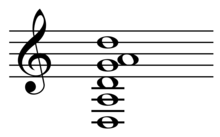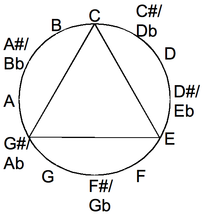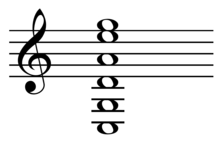Scordatura is a tuning of a string instrument that is different from the normal, standard tuning. It typically attempts to allow special effects or unusual chords or timbre, or to make certain passages easier to play. It is common to notate the finger position as if played in regular tuning, while the actual pitch resulting is altered. When all the strings are tuned by the same interval up or down, as in the case of the viola in Mozart's Sinfonia Concertante for Violin, Viola and Orchestra, the part is transposed as a whole.
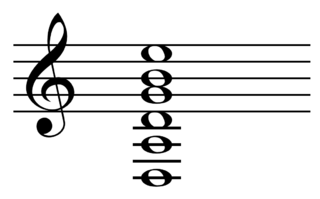
Drop D tuning is an alternative form of guitar tuning in which the lowest (sixth) string is tuned down from the usual E of standard tuning by one whole step to D. So where standard tuning is E2A2D3G3B3E4 (EADGBe), drop D is D2A2D3G3B3E4 (DADGBe). Drop D tuning, as well as other lowered altered tunings, are often used with the electric guitar in heavy metal music. It is also used in blues, country, folk (often with acoustic guitar), and classical guitar.

The seven-string guitar adds one additional string to the more common six-string guitar, commonly used to extend the bass range or also to extend the treble range.

A quarter tone is a pitch halfway between the usual notes of a chromatic scale or an interval about half as wide as a semitone, which itself is half a whole tone. Quarter tones divide the octave by 50 cents each, and have 24 different pitches.

An eight-string guitar is a guitar with eight strings, or one more than the Russian guitar's seven. Eight-string guitars are less common than six- and seven-string guitars, but they are used by a few classical, jazz, and metal guitarists. The eight-string guitar allows a wider tonal range, or non-standard tunings, or both.

D A D G A D, or Celtic tuning, is an alternative guitar tuning most associated with Celtic music, though it has also found use in rock, folk, metal and several other genres. Instead of the standard tuning the six guitar strings are tuned, from low to high, D2A2D3G3A3D4.

The baritone guitar is a guitar with a longer scale length, typically a larger body, and heavier internal bracing, so it can be tuned to a lower pitch. Gretsch, Fender, Gibson, Ibanez, ESP Guitars, PRS Guitars, Music Man, Danelectro, Schecter, Burns London and many other companies have produced electric baritone guitars since the 1960s, although always in small numbers due to low popularity. Tacoma, Santa Cruz, Taylor, Martin, Alvarez Guitars and others have made acoustic baritone guitars.
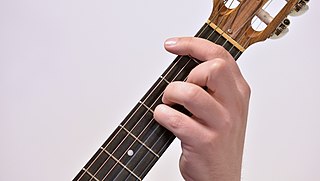
In music, a barre chord is a type of chord on a guitar or other stringed instrument played by using one finger to press down multiple strings across a single fret of the fingerboard.

In music, a guitar chord is a set of notes played on a guitar. A chord's notes are often played simultaneously, but they can be played sequentially in an arpeggio. The implementation of guitar chords depends on the guitar tuning. Most guitars used in popular music have six strings with the "standard" tuning of the Spanish classical guitar, namely E–A–D–G–B–E' ; in standard tuning, the intervals present among adjacent strings are perfect fourths except for the major third (G,B). Standard tuning requires four chord-shapes for the major triads.

Guitar tunings are the assignment of pitches to the open strings of guitars, including classical guitars, acoustic guitars, and electric guitars. Tunings are described by the particular pitches that are made by notes in Western music. By convention, the notes are ordered and arranged from the lowest-pitched string to the highest-pitched string, or the thickest string to thinnest, or the lowest frequency to the highest. This sometimes confuses beginner guitarists, since the highest-pitched string is referred to as the 1st string, and the lowest-pitched is the 6th string.

C tuning is a type of guitar tuning. The strings of the guitar are tuned two whole steps lower than standard tuning. The resulting notes can be described most commonly as C-F-A♯-D♯-G-C or C-F-B♭-E♭-G-C. This is not to be confused with C♯ tuning, which is one and one half steps lower than standard tuning.
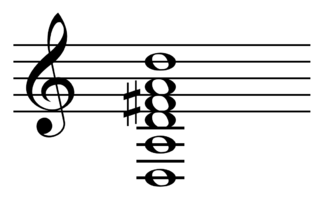
Open D tuning is an open tuning for the acoustic or electric guitar. The open string notes in this tuning are : D A D F♯ A D. It uses the three notes that form the triad of a D major chord: D, F♯ and A.
An extended-range bass is an electric bass guitar with a wider frequency range than a standard-tuned four-string bass guitar.

In music, 53 equal temperament, called 53 TET, 53 EDO, or 53 ET, is the tempered scale derived by dividing the octave into 53 equal steps. Each step represents a frequency ratio of 21⁄53, or 22.6415 cents, an interval sometimes called the Holdrian comma.
In music, 22 equal temperament, called 22-TET, 22-EDO, or 22-ET, is the tempered scale derived by dividing the octave into 22 equal steps. Each step represents a frequency ratio of 22√2, or 54.55 cents.

Open C tuning is an open tuning for guitar. The open-string notes form a C major chord, which is the triad (C,E,G) having the root note C, the major third (C,E), and the perfect fifth (C,G). When the guitar is strummed without fretting any strings, a C-major chord is sounded. By barring all of the strings for one fret, one finger suffices to fret the other eleven major-chords.
In music, 41 equal temperament, abbreviated 41-TET, 41-EDO, or 41-ET, is the tempered scale derived by dividing the octave into 41 equally sized steps. Each step represents a frequency ratio of 21/41, or 29.27 cents, an interval close in size to the septimal comma. 41-ET can be seen as a tuning of the schismatic, magic and miracle temperaments. It is the second smallest equal temperament, after 29-ET, whose perfect fifth is closer to just intonation than that of 12-ET. In other words, is a better approximation to the ratio than either or .

In music, 15 equal temperament, called 15-TET, 15-EDO, or 15-ET, is a tempered scale derived by dividing the octave into 15 equal steps. Each step represents a frequency ratio of 15√2, or 80 cents. Because 15 factors into 3 times 5, it can be seen as being made up of three scales of 5 equal divisions of the octave, each of which resembles the Slendro scale in Indonesian gamelan. 15 equal temperament is not a meantone system.

Among alternative tunings for guitar, a major-thirds tuning is a regular tuning in which each interval between successive open strings is a major third. Other names for major-thirds tuning include major-third tuning, M3 tuning, all-thirds tuning, and augmented tuning. By definition, a major-third interval separates two notes that differ by exactly four semitones.

Among alternative guitar-tunings, regular tunings have equal musical intervals between the paired notes of their successive open strings.




